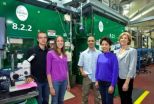Renewable energy needs more community power
2010-09-10
(Press-News.org) An analysis of wind farm applications in England shows that rejection of wind energy projects is connected to areas with high political engagement and high life expectancy. The current trend shows that many technically suitable locations may remain unused because of the threat of effective local resistance by people who are relatively privileged.
Planning delays and rejections encourage commercial developers to instead focus on remote or deprived communities as sites for new power plants. In areas of economic fragility, commercial plants are more easily established without having to provide many benefits for the local community.
Many small scale community-driven renewable power plants have been successfully developed in recent years, providing a valuable potential for building and sharing practical knowledge. But this potential can only be fully utilised if we find new ways to encourage community-led social enterprises, extending beyond remote sites to more urban landscapes.
'Policymakers should embrace policies to encourage a wider sense of ownership of projects,' says Dr van der Horst. 'There should be structures to ensure that more benefits flow to local communities in economically fragile areas, and encouragement for residents to invest in local projects - especially in more privileged areas.'
INFORMATION:
FOR FURTHER INFORMATION CONTACT:
Dr Dan van der Horst (Tel: 0121 41 45525, mobile: 07914245419, email: d.vanderhorst@bham.ac.uk)
ESRC Press Office:
Danielle Moore (Tel: 01793 413122, email: danielle.moore@esrc.ac.uk)
Jeanine Woolley (Tel: 01793 413119, email: jeanine.woolley@esrc.ac.uk)
Out of office press mobile number: 07554333336
NOTES FOR EDITORS
1. This release is based on the findings from Insights from pioneers in renewable energy (INSPIRE) funded by the Economic and Social Research Council.
2. A combination of different methods was selected, including ethnographic methods in the workplace, formal interviews and analysis of a spatially detailed Rural Economy and Land Use-funded socio-economic dataset which was combined with a database of proposed wind projects in rural England.
3. The Economic and Social Research Council (ESRC) is the UK's largest organisation for funding research on economic and social issues. It supports independent, high quality research which has an impact on business, the public sector and the third sector. The ESRC's total expenditure in 2009/10 was about £211 million. At any one time the ESRC supports over 4,000 researchers and postgraduate students in academic institutions and independent research institutes. More at http://www.esrcsocietytoday.ac.uk
4. The ESRC confirms the quality of its funded research by evaluating research projects through a process of peers review. This research has been graded as good.
END
ELSE PRESS RELEASES FROM THIS DATE:
2010-09-10
DURHAM, N.C. – Drug companies may be more willing to develop treatments for neglected diseases including malaria, tuberculosis and leishmanaiasis if the European Union would adopt a "priority review voucher" reward system.
The vouchers would give a company accelerated regulatory review of one of its other drugs as a reward for developing a treatment for a neglected disease.
Although these diseases affect more than 1 billion people, they occur most frequently in developing nations, providing little financial incentive for pharmaceutical companies to create and test new ...
2010-09-10
People who are better at simple physical acts such as gripping, walking, rising from a chair and balancing on one leg are more likely to live longer, according to a new study published on bmj.com today.
Measures of physical capability, such as grip strength, walking speed, chair rising time and standing balance ability, can predict mortality in older people living in the community, UK researchers found.
These measures are related to a person's ability to perform everyday tasks. There is growing interest in using such measures as simple screening tools to identify ...
2010-09-10
Diagnostic errors are the most important causes of avoidable harm to patients in hospitals, warns a senior doctor on bmj.com today.
Dr Gordon Caldwell, a consultant physician at Worthing Hospital in Western Sussex argues that doctors need better facilities and sufficient time to make a correct diagnosis.
When a patient is admitted to hospital, the team of doctors formulate a "working diagnosis," he explains. At this point, the diagnosis is uncertain but the patient is treated as if the working diagnosis is correct.
"If over the next few days the patient gets better, ...
2010-09-10
Imagine a war in which you are vastly outnumbered by an enemy that is utterly relentless – attacking you is all it does. The intro to another Terminator movie? No, just another day for microbes such as bacteria and archaea, which face a never-ending onslaught from viruses and invading strands of nucleic acid known as plasmids. To survive this onslaught, microbes deploy a variety of defense mechanisms, including an adaptive-type nucleic acid-based immune system that revolves around a genetic element known as CRISPR, which stands for Clustered Regularly Interspaced Short ...
2010-09-10
Los Angeles, CA (September 7, 2010) – Joseph Stalin once claimed that a single death was a tragedy, but a million deaths was a statistic. New research from the Kellogg School of Management at Northwestern University validates this sentiment, confirming large-scale tragedies don't connect with people emotionally in the same way smaller tragedies do.
The new study, entitled "The Scope-Severity Paradox: Why doing more harm is judged to be less harmful," has been published in the current issue of Social Psychological and Personality Science (published by SAGE) and was conducted ...
2010-09-10
CHAMPAIGN, Ill. — Vaccine manufacturers and public health decision-makers need to collaborate in a more efficient and effective manner not only to reduce the likelihood of supply shortages for pediatric vaccines but also to maximize community immunity by using vaccine doses to increase coverage, according to research published by a University of Illinois researcher who specializes in statistics and data analysis.
Sheldon H. Jacobson, a professor of computer science and the director of the simulation and optimization laboratory at Illinois, says that the Pediatric Vaccine ...
2010-09-10
CAMBRIDGE, Mass. — For the first time, a team of MIT chemical engineers has observed single ions marching through a tiny carbon-nanotube channel. Such channels could be used as extremely sensitive detectors or as part of a new water-desalination system. They could also allow scientists to study chemical reactions at the single-molecule level.
Carbon nanotubes — tiny, hollow cylinders whose walls are lattices of carbon atoms — are about 10,000 times thinner than a human hair. Since their discovery nearly 20 years ago, researchers have experimented with them as batteries, ...
2010-09-10
MADISON, WI, September 9, 2010 – Cotton growers can produce more cotton if they plant early, but not without irrigation. That's the finding of an article published in the September-October 2010 Agronomy Journal, a publication of the American Society of Agronomy.
Bill Pettigrew, a scientist with the USDA-Agricultural Research Service in Stoneville, Mississippi, tested the performance of cotton under irrigated and non-irrigated plots, with half the plots being planted early (first week of April) and half being planted in the more tradition time period, around the 1st week ...
2010-09-10
HACKENSACK, N.J. (September 9, 2010) — Researchers from the John Theurer Cancer Center at Hackensack University Medical Center played an important role in a study that led to the Food & Drug Administration's (FDA) recent fast tracking of ipilimumab, a promising treatment for metastatic melanoma. The FDA based its decision largely on the results of a pivotal study published in the New England Journal of Medicine on August 19, 2010 – the same day the agency accepted Bristol-Myers Squibb's application for the drug's approval and granted the application priority review status.
Ipilimumab ...
2010-09-10
The following highlights summarize research papers that have been recently published in Journal of Geophysical Research-Atmospheres (JGR-D) and Geophysical Research Letters (GRL).
In this release:
Landmass shape affects extent of Arctic sea ice
Estimating how much rain forests intercept
How compliant fault zones respond to nearby earthquakes
Measuring the rate of mountain building in New Zealand
Interplanetary magnetic field causes changes in the polar cap ionosphere
Oxygen and hydrogen follow different escape paths from Venus's atmosphere
Anyone ...
LAST 30 PRESS RELEASES:
[Press-News.org] Renewable energy needs more community power

